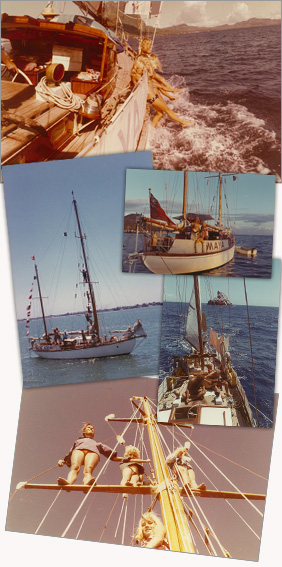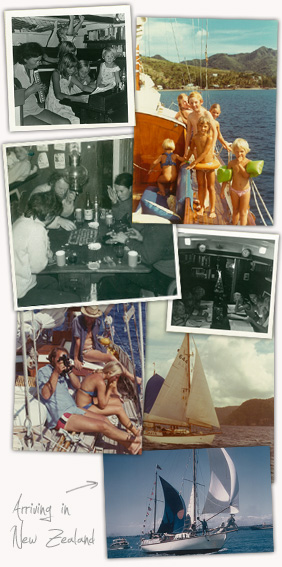Lymington, England to Auckland, New Zealand
May 1972 - December 1973MAYA - a voyage of discovery © Barclay Armstrong 1995
“It was a period of two years from go to woe which was about the most fulfilling I think that I have lived...”
David Armstrong 1995
“we keep harking back to it... we hope to do it again”
Sandy Mill 1995
Dramatis personae
David and Jen Armstrong
Sandy and Joan Mill
Emily Mill aged 9yrs
Charlotte Mill aged 7yrs
Natasha Armstrong aged 5 yrs
Daniel Mill aged 4yrs
Kate Armstrong aged 2yrs
Barclay Armstrong aged 10months
Preparation
Written by Sandy Mill, April, 2010After considerable searching we purchased Maya from John Russell in 1971, knowing that we would have to do extensive modifications to provide a seagoing environment for our large complement of 2 families, which included 6 small children as noted above. We undertook this work ourselves, mainly at Berthon's Boatyard in Lymington, and were ready to sail in May 1972.
With our design background in architecture and sailing experience we revised the general arrangement so that the fundamentals of galley work and navigation could be carried on regardless of conditions.

Kids afloat
- Sleeping accommodation was arranged in areas of least motion, excluding the need for sleeping in the forepeak.
- Completely new galley and navigation areas were created.
- A new cabin sole, semi-bulkheads, and bunks were made from mahogany ply, trimmed with laminated teak.
- New galvanised steel water tanks were installed under saloon settee berths.
- Existing cabinetwork, cupboard doors etc were reused and the fine saloon table was retained to maintain the character of the interior.
- All details were ergonomically planned to permit ease of movement in an otherwise possibly cramped environment.
- The available space in a narrow, but deep bodied hull had to be carefully utilised in every aspect to make this project a success.
- A new stainless steel Taylors Paraffin stove with large reservoir was installed, together with twin sinks, fresh and salt water manual pumps and generous food preparation areas. No refrigeration was possible due to limitations of space and power.
- Upper and lower bunks were fitted in the passageway to the aft cabin. These were measured for the two middle children but in the event they nearly outgrew them.
- On deck we fitted powerful modern sheet winches to assist in efficient sail management. An ingenious semi-catamaran dinghy capable of carrying the whole crew in calm water was stowed neatly and securely on the short coachroof forward of the permanent dodger.
- We had to remove and sell the excellent auto-pilot recently installed by John Russell, as a power-saving measure. In its place the mizzen boom was shortened to make way for the installation of a Max Gunning designed pendulum-servo type windvane self-steering unit. When coupled to the iron auxiliary tiller, Maya proved to be easily controlled by this gear and we seldom had to revert to the "tyrrany of the helm".
- We controlled fresh water consumption by restricting availability to the galley pump only. The basins were restricted to salt water pumping and tumblers filled from the galley. With a total freshwater capacity of 200 gallons and water collection from the gooseneck while sailing, or an awning while at anchor, we had no difficulty in maintaining considerable reserves.
- For the expected downwind passages we had a mizzen staysail cut and fitted running backstays to the mizzen mast to carry this load.
Our purpose was to equip ourselves with a serious offshore vessel. Although this left little room for sentiment, we never lost sight of the need to retain the qualities of this fine little ship, and we were proud of our handiwork. In spite of this we sympathised with John Russell's comment as we showed him aboard..." it's very nice but it is not my old Maya ".
Route

- Departed UK from the Helford River at the end of June 1972 for the crossing of the Bay of Biscay to Corunna, Spain.
- Portugese Coast to Gibraltar.
- Since this was now the full Hurricane Season in the Caribbean we decided to cruise the Western Mediterranean until a more favourable time for making the Trans-Atlantic crossing later in the year.
- We therefore cruised the Northern coasts of Morocco and Algeria.
- Balearic Islands to South-West Spanish Coast
- Tangiers to Canary Islands, departing for Antigua 5 December 1972
- Canaries to Antigua - 19 day passage, arriving 26 December 1972 after spending Christmas Day at sea.
- Cruising the Windward and Leeward groups until end of March 1973
- Netherlands Antilles, Colombian Coast to Panama Isthmus ( San Blas Islands), arriving Panama to transit the Canal 18 May 1973
- Panama, Perlas Islands to Galapagos Islands, arriving 11 June 1973
- Depart Galapagos 9 July for Pacific crossing to Marquesas Islands, 2810 nautical miles in 22 days. Arrive Fatu Hiva 31July 1973
- Cruising French Polynesia... Marquesas Islands, Tuamotu Archipelago, Tahiti and Society Islands.
- Depart Bora Bora 2 Nov 1973 bound for Cook Islands
- Depart Cook Islands 14 Nov 1973 bound for NZ via Kermadec Islands. South Pacific Cyclone Season approaching.
- Arrive Opua, Bay of Islands, NZ 3 Dec 1973.
- Coast down to Auckland, arriving mid-morning 5th Dec 1973. Voyage end.





